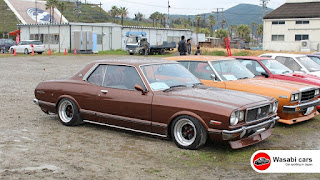The third generation was introduced with a more upscale, European type design. The lines are a combination of the previous generation's American styling with a British-looking front end, while demonstrating a new corporate Toyota appearance with the larger S80 series Crown. In 1978, this model generation was the last cars that feature the Toyopet brand name, which was dropped in 1980. The Toyopet name continued to be used for the dealership network in Japan, however. The Grande trim was added to models with six-cylinder engines. This generation continued to offer Japanese buyers an alternative to the Nissan Laurel sedan, and the new Nissan Bluebird based Nissan Maxima in North America, with the new Chaser as an alternative to the Nissan Skyline in Japan. The Mark II was split into two other sedans so that they could sell different versions of the Mark II at the multiple dealerships Toyota had established in the 1970s.
Some models had six-cylinder engines, optionally with electronic fuel injection, borrowed from the larger Crown. For the Japanese market, all Japanese models engines were upgraded with Toyota's TTC-C technology to comply with the Japanese Governments Clean Air Act of 1975. In late October 1977 the 3T-U engine was upgraded to pass the 1978 emissions standards with the aid of a lean-burn design.[13] Four-cylinder engines were mostly reserved for cars intended for commercial usage. The X30-series chassis numbers were the original codes for the third-generation Mark II, with X40 numbers being gradually introduced about halfway through the life of the model for cars that could pass the new, stricter 1978 emissions rules. In October 1979 a diesel-engined Mark II went on sale, a first for the badge.
In 1998, Toyota released a car called Progrès. The Progrès front end looks somewhat like an updated version of the X30/X40 series sedan. For instance, both of them feature a combination of round and squared lighting. The grille and bonnet also has similar shapes, size, and lines.
: Chaser
The Toyota Chaser was released in 1977 as a competitor to the Nissan Skyline sedan. The original Chaser was a rebadged Mark II with a lightly differing front and rear treatment, of a higher class than the Mark II.[14] Later generations received more differentiated styling. The idea of the Chaser was to offer a sportier version of the Mark II and sold at a different Japanese Toyota dealership called Toyota Auto Store, often with more powerful engines and different suspension setups.
: WAGON SEDAN COUPE
The Corona Mark II was renamed the Toyota Cressida for export markets, and the name Cressida was not used in Japan. Production started in December 1976.[11] The name Mark II was previously identified with the North American Continental Mark II which first appeared in 1956 and the term "Mark" is still associated with Lincoln Motor Company products. It was Toyota's largest sedan and wagon range offered in North America, while the personal luxury coupé wasn't offered. In New Zealand, a two-litre four-cylinder sedan version replaced the six-cylinder Crown in local assembly after the 1970s oil crises prompted the government to impose a 60% sales tax on cars with engines larger than two litres. A few fully built up Crowns were subsequently imported. In other markets, the larger Toyota Crown also remained available.
The name "Cressida" derives from the lead character in William Shakespeare's play Troilus and Cressida, inspired by Cressida, a female Trojan character.
Depending on the market it was sold in, it had the 4M carbureted engine (MX32, MX36), the 18R engine (RX30, RX32, RX35) or 3T engine (TX30). The North American models started with the carbureted 4M engine (MX32) but in mid-1978 the fuel-injected 4M-E replaced its carbureted counterpart – this was one of the first Toyotas in the US to use fuel injection. In 1979, the MSRP in the US was US$9,190. In New Zealand, where it was locally assembled and sold in a highly specified GL form (replacing the 2.8-litre Crown which had been hit by high sales taxes on two-litre-plus engine sizes), it had the 18R engine. Australian-market Cressidas received the 2.6-liter 4M engine, although in de-smogged form (meeting ADR27) it only produced 79 kW (107 PS) for relatively leisurely performance.[15]
Standard features included air conditioning, automatic transmission (a 5-speed manual was available), power steering, rear seat armrests, AM/FM cassette stereo with amplifier, reclining front seats, and a rear window defroster. The automatic transmission was a four-speed overdrive with an overdrive lockout. Power windows were optional. Soundproofing was extensive, and the Cressida was famous for being one of the quietest cars on the road at the time.[citation needed]
In the United Kingdom, the Cressida was available in both sedan and wagon body styles. The only engine available was the 18R and there was one trim level, badged De Luxe. Contrary to common practice, this was not the same as DX specifications on other Toyota cars, but a more upmarket version of the DX trim level. The Toyota Carina sedan and wagon also sold in the United Kingdom at this time were also badged as De Luxe (but were rebadged as DX from 1980 onwards).
South African Cressidas all received the 2.0-litre 18R engine, and were introduced in November 1977.[16] The engine was built in South Africa by Toyota's Motor Assemblies subsidiary. Originally only a fully equipped L version was available, with a lower-priced semi-deluxe version appearing in the first month of 1978. A station wagon, Toyota's first in South Africa, appeared in August 1978. It was available in either .semi-deluxe or full deluxe trim, the latter only as an automatic.[16]


















































































